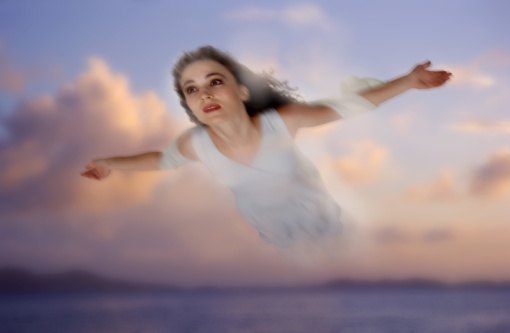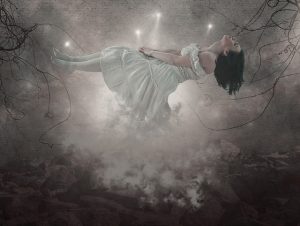 JK asks: "What is astral projection and can Catholics practice it?
JK asks: "What is astral projection and can Catholics practice it?Astral projection is a type of out-of-body experience that is based in Theosophy, a religion based on Hinduism that was founded by the infamous occultist, Madame Blavatsky. For this reason, Catholics should avoid the practice.
Theosophists, who invented the term "astral projection," posit that the astral body is one of seven bodies that we all possess - one for each of the seven planes of reality. In astral projection, the astral body (which Blavatsky claims is the seat of feeling and desire) leaves the physical body and is able to travel independently. During the trip, it allegedly remains linked to the physical body by a very fine elastic silver cord (this has never been proven).
Out of body experiences (OBEs) are similar, and are characterized by a feeling of departing the body and observing oneself from outside the physical body. It can occur in dreams, daydreams, and in lucid dreaming (a state in which one is "awake" while dreaming). OBEs can also occur in people who are under the influence of anesthesia or while in a semi-conscious state due to some kind of trauma. They can also be drug-induced. Some people experience an OBE when they are near death, which has come to be known as a "near death experience."
During astral projection, theosophists claim the body can travel through the astral planes or astral world which is where consciousness goes after physical death. It is also a place where angels, spirits, and other immaterial beings exist, as well as souls who in the process of reincarnation. (There is no evidence that these different bodies and planes actually exist.)
The idea of traveling through these planes tickled the fancy of New Agers who believe people can train themselves to astral project or send their “light body” (aka soul) to these other planes where they can explore ancient civilizations and connect with other realms to gain spiritual insight.
New Agers aren’t the only people who believe in astral projection. It has also been a part of many cultures around the globe, from Inuit, Amazonian and Japanese cultures to ancient Hindu and Chinese writings. Ancient Egyptians believed the soul could hover outside the body and the Chinese mythological figure named Xiangzi was reportedly seen in a banquet room at the same time that he was seen sleeping on the ground and “snoring like thunder” in another room. Officials claimed that Xiangzi left the banquet room just as the sleeping Xiangzi woke up and both merged into one.
 Some have gone so far as to suggested that St. Paul was astral projecting when he visited the third heaven; however, this is not borne out by the saint himself who claims he doesn’t know if he was in his body or out. In 2 Cor 12:2, he says "I know a person in Christ who fourteen years ago was caught up to the third heaven - whether in the body or out of the body I do not know."
Some have gone so far as to suggested that St. Paul was astral projecting when he visited the third heaven; however, this is not borne out by the saint himself who claims he doesn’t know if he was in his body or out. In 2 Cor 12:2, he says "I know a person in Christ who fourteen years ago was caught up to the third heaven - whether in the body or out of the body I do not know."
But even if he was out of the body, Paul's experience differs from those who seek astral travel because his experience was at God's initiation and was not deliberately sought by himself. This is very different from those who are seeking out the experience in order to "tap into a sea of infinite wisdom” which is just another form of Gnosticism.
Scientists have had much to stay about the plausibility of astral projection. Of particular interest is the work of Dr. Susan Blackmore, psychologist, lecturer and writer researching consciousness, memes, and anomalous experiences, and a Visiting Professor at the University of Plymouth, UK. She had her own out-of-body experience in college after taking part in Ouija board group/séance and then smoking hashish.
In an interview with Oprah Daily, Blackmore says: "The bottom line is that I think we now have the outlines of a complete neuroscientific explanation of what out-of-body experiences are. That doesn’t mean we know every detail, but we have the outline. It is quite unnecessary, and indeed totally unhelpful, to talk in terms of astral projection, because that is an ancient theory that simply doesn’t fit the facts now."
According to Dr. Blackmore, at the turn of the century a Swiss neurosurgeon named Olaf Blanke discovered a spot near the right temporo-parietal junction which, when stimulated, gave a patient sensations of sinking or falling, as well as bodily distortions. With stronger stimulation, the patient had feelings of floating near the ceiling.
“If the body schema is disrupted by electrical stimulation it would fail to track properly what the body is doing and so might drift from the body’s actual location,” thus creating the sensation of being separate from the body or “outside of oneself."
There is no scientific consensus on how to induce an out-of-body experience, as the vast majority of people who experience them do so involuntarily, and accounts of them are based on anecdotal evidence.
Because of its basis in a non-Christian understanding of the supernatural realm, and its goal being to acquire secret knowledge from other planes of existence, the practice of astral projection should be avoided by Catholics.
© All Rights Reserved, Living His Life Abundantly®/Women of Grace® http://www.womenofgrace.com
A podcast version of this blog is available here!
